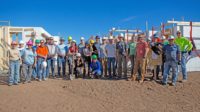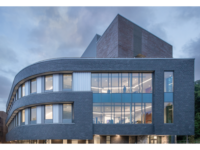The insulated concrete forms industry has built its reputation on key benefits: energy efficiency, ease of construction, comfort, and disaster resilience. While we hope that your home never comes in contact with any kind of disaster (natural or otherwise), it is always encouraging to see ICF structures live up to their promise, delivering the benefits we so proudly proclaim. The Florida Beach House survived a direct hit from Hurricane Irma and is a shining example of just how strong and resilient ICF structures are. The design and strength of this house helped it win industry recognition and become a beacon in the area showcasing the performance of ICFs in the face of disaster.
The Home You Want, Without Compromises
Located in Islamorada, Fla., in the Florida Keys, this stunning, three-story beach house, has everything you could want in an island oasis. The home is airy, open and bright, with direct access to the ocean and stunning island views. The large windows throughout the house provide a great amount of natural sunlight and the high ceilings make the whole space feel expansive and open.
The owner decided to build with ICFs early in the planning phase. His original architect was not familiar with ICF technology and tried to push him to use traditional masonry. The owner took the time to do a great deal of research and was well-aware of the many benefits that ICFs have when compared to CMU and traditional masonry. He sought out an ICF designer who would support his vision. This led him to Robert Klob, an architect who works exclusively in ICF design. Robert’s knowledge and quality of his work proved to be an important asset as the homeowner worked through challenges with the local building department and trades.
A Challenging Build
The design of the home mixed with the safety and code requirements of the island created some interesting challenges. The home had to be constructed completely above grade to adhere to tidal surge requirements. The home also needed to come in below the very strict 35-foot height maximum. No small feat for a three-story home with a rooftop deck. With the help of Klob and the BuildBlock team, the owner was able to build exactly what he wanted without sacrificing on strength or design.
Attention to detail during construction is always key. The home is designed with an open center and very tall walls (30 feet, 8 inches on three sides), to allow for a dramatic feeling between the livable areas. This, combined with stepping the walls at the front of the home, made it critical to ensure walls, concrete beams, and the ICF decking systems were correctly installed and coordinated throughout construction. The project’s success is made even more impressive by the fact that the homeowner had never built with ICFs before this project. He relied heavily on BuildBlock’s training and installation manuals proving that with determination and education, just about anyone can build with ICFs.
Strong and Resilient
Proximity to the ocean posed a few unique challenges, but the most formidable was the threat of Hurricane Irma. This catastrophic storm was the strongest hurricane on record in the open Atlantic region and dealt a direct blow to the Florida Keys towards the end of this home’s construction. The owner knew the storm was coming so he drove down, opened up the garage doors to allow wind and water to pass through (flood vents had been installed along the three garage doors to allow the surge to easily pass through), and then drove home. When the storm hit, it caused minor cosmetic damage to the outside of the Florida Beach House which was easily repaired. The storm caused major damage throughout the islands but there was no structural damage to The Florida Beach House. By comparison, the resort across the street suffered considerable damage and much of it had to be rebuilt.
Efficient, Safe, and Beautiful
The interior of the home boasts some impressive advantages as well. To allow easy access to every floor, an elevator was installed with ICFs providing the necessary strength and fire ratings. The home is 46 percent more energy efficient than what code requires and comfortable year-round. The home is designed to utilize cross coastal breeze and the ICFs help combat Florida’s hot and humid climate by maintaining a cool temperature inside.
The beauty and success of this home has not gone unnoticed in the local community. Few ICF homes have been built in the Florida Keys and this one sits on the only highway between Miami and Key West. During construction, the home was on display for thousands of cars, both local and tourists. The home appeared in many news stories after Hurricane Irma, as an example of how and why some homes weathered the storm so well. Due to its resilience to Hurricane Irma, the community now has a greater understanding of why building with concrete is important and though the home performs like a bunker, its design is open, airy, and comfortable.
The success of this home is also acknowledged by the local building department because of the home’s quality, integrity, and long term viability. The success of projects like this, large or small, continue to demonstrate that ICF buildings are the best solution for disaster resilience, cost-effective construction, quality, and comfort. W&C











Report Abusive Comment